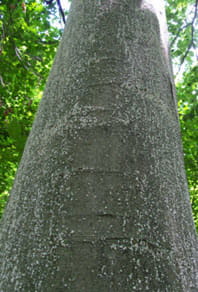The web Browser you are currently using is unsupported, and some features of this site may not work as intended. Please update to a modern browser such as Chrome, Firefox or Edge to experience all features Michigan.gov has to offer.
Invasive Species: Beech Bark Disease
Beech Bark Disease
(Cryptococcus fagisuga + Neonectria spp.)
*Detected in Michigan*
Report suspected beech bark disease in Michigan:
Department of Natural Resources Forest Health Division: DNR-FRD-Forest-Health@michigan.gov.
- Or - use the Midwest Invasive Species Information Network (MISIN) online reporting tool.
- Or - download the MISIN smartphone app and report from your phone.

Scale-infested beech - Michigan DNR Forest Health Program photo archive.

Beech trees weakened by BBD often “snap” - Michigan DNR Forest Health Program photo archive.
Why we care: Beech bark disease (BBD) is caused by both a sap-feeding scale insect and a fungus. American beech trees are first infested with beech scale. Scale feeding allows infection by the Neonectria fungus. The fungus kills the wood, blocking the flow of sap. Affected trees decline in health and eventually die. Some infected trees break off in heavy winds before dying – a condition called "beech snap" (see photo). The scales are covered with white wool, turning infested portions of the tree white.
What is at risk? There are 32 million American beech trees in Michigan. About 2.5 million beech have been killed by BBD to date. Much of this loss has been in the eastern Upper Peninsula. Newly infested beech forests are reported in the Lower Peninsula every year.
The threat: Tree mortality occurs three to six years after scales initially infest an area. The largest trees are most susceptible. Scale-infested trees with apparently healthy crowns are a hazard due to beech snap.
What is happening in Michigan? High timber-value trees are being salvaged. The DNR has stepped up hazard tree removals due to BBD and the emerald ash borer. About 3% of American beech is resistant to BBD. Resistant trees are being identified and used to produce resistant American beech for the future.
What can you do? Don’t move beech firewood or logs from infested areas to uninfested areas. Controlling the natural spread of BBD is not feasible because both the scale and fungus are moved by animals and the wind. Once scale infests trees in your area, watch for resistant trees. Report new finds.
MORE INFORMATION: